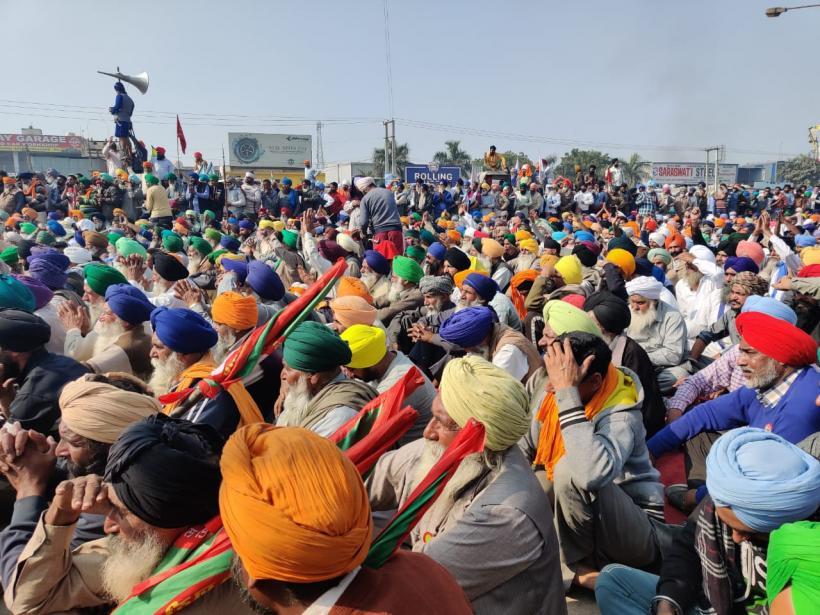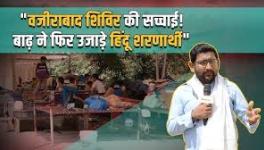Not Just Haryana-Punjab: Farmer Protest Gets Cross-Country Support

Last week, a journalist asked Bhartiya Kisan Union leader Rakesh Tikait how long farmers can continue to protest on the borders of Delhi. What if talks with the Centre fail; would farmers then stay on indefinitely? Confidently, Tikait declared that farmers had made preparations to stay in Delhi until May 2024—the year the next Lok Sabha election will be held—and that they were not leaving from Singhu Border until then.
True, such a long-lasting mass mobilisation may seem unlikely, but the way the farmers’ protest against the three farm laws has taken shape, it can certainly go on for many more months without losing any of its intensity. This is because the protests that are visible in Delhi are only the shoots of the movement—the roots of these agitations are not at Singhu or Tikri or the capital’s other borders, but deep inside the villages across many states.
ALL PUNJAB HAS AWAKENED
The early-morning announcements over the loudspeaker of a local Gurudwara in Oind village in district Ropar of Punjab have become a key link between the locals and the farmers who are agitating at Singhu and the four other borders in the NCR region.
The local granthi (priest) informs villagers about the tractor trollies that have parked outside the gurudwara to collect community rations and other necessary items for the farmers. Following this, he asks the villagers to look after the fields and families of farmers who are away from home and participating in this protest.
Oind is not the only village of Punjab in which local Gurudwaras are lending strength to the gigantic movement that is now in its 55th day despite the extreme cold.
“I have workers who look after my fields but many farmers have only one male member and he is here to protest,” says Bhupinder Singh Kharod of Oind village. “Local gurudwaras have been asking people to help such families. Neighbours are in fact assisting them in taking care of crops and animals. This is one reason why this moment has become historic,” he says.
In the first week of December, the Shiromani Gurdwara Prabandhak Committee (SGPC) organised mass prayers for the farmers’ fight against three controversial farm laws at various historic gurudwaras across Punjab. According to a PTI report, during the prayer meeting at Harmandir Sahib, head granthi Giani Jagtar Singh said, “The farm laws should be repealed. Guru Sahib (almighty) should grant good sense to the government of the country so that it understands the sentiments of humanity.”
NOT JUST PUNJAB AND HARYANA
The government and a section of the media are repeatedly claiming that the anti-farm law agitation is limited only to farmers from Punjab and Haryana. But farmers from many other states are also agitating at Singhu and other borders. A thousand farmers from Kerala are on their way to join the tractor rally scheduled for 26 January, in addition to the several hundred already at the protest sites. Farmers from Rajasthan, Maharashtra, Jharkhand, Tamil Nadu, Uttar Pradesh, and other areas are increasingly visible at all the sites.
John Oraon is a small paddy farmer from Palamu district of Jharkhand. He was in Jammu last week for a family function. Instead of returning home, he joined the farmers’ agitation at Singhu on Makar Sakranti [14 January] evening. “I was getting updates about the protest from social media. Every time I saw a clip, I told myself I should be here,” says Oraon. “Here I am at last. I am not a rich farmer, but I bought biscuits for Rs.500 and left them at a tea stall near the protest site for everybody to share. I am happy that I have contributed something for my farmer brothers,” he says.
About 2,000 farmers from Madhya Pradesh have been camping near Palwal since December. In Madhya Pradesh there was deadly police action against the agitating farmers who had been protesting in nine districts demanding higher crop prices and debt relief in June 2017.
The ruling BJP government had cracked down on the protesters, killing five farmers in police firing in Mandsaur. The protest and its suppression had a chilling effect on the BJP’s electoral performance in the 2018 state election.
“Only my mother is at home while I am here, but I am not worried as my friend is taking care of her and my crops,” says Karmbeer Singh, 45, a chickpea and wheat farmer from Manetti village of district Ashok Nagar, Madhya Pradesh. “These laws are going to kill farmers. People know this and this is the only reason everyone wants to be part of this agitation. Whether they are physically present here or not, they support it. Every day, my fellow villagers keep asking me what is happening here,” he says.
Another farmer from Madhya Pradesh is 65-year-old Sher Singh, who is also stationed at Palwal with Karambeer. Sher Singh is from Dhanwara village of Ashok Nagar and grows wheat, paddy, sugarcane and chickpea. He is not unduly worried about his crops either, because locals are helping out with their care. He does not want to return home until the government repeals the three laws. “When you shut down the mandi and allow private players to dictate terms, farmers will have no option but to be exploited. I am 65 years old and don’t know how long I will live, but I will not allow anyone to plunder our sweat and blood. I would rather die here. I am not going home until these laws are repealed,” Sher Singh says, firmly.
NEW HARYANA-PUNJAB TOGETHERNESS
Punjab and Haryana were divided into two states in 1966, but the fight against the farm laws has made Haryanvi and Punjabi farmers a close-knit family once again.
In mid-December, the Haryana government did its best to cut off the supply lines of the protesters, but the states farmers relentlessly continue to support their “older brothers”, the Punjabi farmers. It is now well known that there is complete coordination, trust and a developing culture of mutual assistance between the residents of Haryana villages and the agitating farmers. Haryana’s farmers had helped the Punjabi youth breach the barbed-wire barricades, trenches, tear-gas shelling, water cannon and batons used on them the Haryana police on November 27.
Again, social communication and verbal announcements in the villages that are close to the national highways have not allowed the supply of fresh items such as milk, vegetables and water to weaken. That is how the farmers arriving even from Punjab’s faraway border district of Amritsar are making it to Delhi with full support along the way.
Jaipal Singh of village Sisana in district Sonipat and others members of the Dahiya khap in Haryana set up a langar [cooked food] camp just two kilometres from the Singhu Border a few days after the farmers arrived. “Every morning, our tractor trollies with 700 or 800-litre plastic drums roam around the villages and ask for milk and vegetable donations for the agitating farmers,” says Singh. “It does not take much time to fill the containers and trollies. This is our fight and everyone knows the disastrous consequences we will face because of these laws. So, everyone is involved,” he says.
As the national media selectively covers this agitation and some sections of it create false narratives about this rock-solid protest, newcomers to the protest are shocked to see its scale. “On TV they have been saying only 500-600 farmers are protesting at the borders,” says K Narayana from Telangana. “They have also been telling us that people from Pakistan, Bangladesh and terrorist groups have gotten involved. I wanted to see for myself. For five days I have been visiting all the sites and I can say that thousands of farmers are protesting in the coldest of colds against the three laws. Our farmer brothers are not only fighting the government but the climate too. This is historic,” he says.
The author is a freelance investigative journalist. The views are personal.
Get the latest reports & analysis with people's perspective on Protests, movements & deep analytical videos, discussions of the current affairs in your Telegram app. Subscribe to NewsClick's Telegram channel & get Real-Time updates on stories, as they get published on our website.














